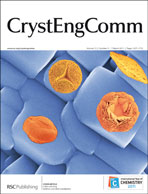Crystal structures of fluorinated aryl biscarbonates and a biscarbamate: a counterpoise between weak intermolecular interactions and molecular symmetry†
Abstract
Conformational features and supramolecular structural organization in three aryl biscarbonates and an aryl biscarbamate with rigid acetylenic unit providing variable spacer lengths have been probed to gain insights into the packing features associated with molecular symmetry and the intermolecular interactions involving ‘organic’ fluorine. Four structures but-2-yne-1,4-diyl bis(2,3,4,5,6-pentafluorophenylcarbonate), 1; but-2-yne-1,4-diyl bis(4-fluorophenylcarbonate), 2;

- This article is part of the themed collection: Fluorine Chemistry

 Please wait while we load your content...
Please wait while we load your content...